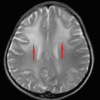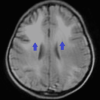Juvenile Alexander Disease: A Rare Leukodystrophy
- PMID: 35698668
- PMCID: PMC9184181
- DOI: 10.7759/cureus.24870
Juvenile Alexander Disease: A Rare Leukodystrophy
Abstract
Alexander disease is an uncommon autosomal dominant leukodystrophy that influences the white matter of the central nervous system (CNS), predominantly affecting the frontal lobe bilaterally. The most obvious pathogenic hallmark is the extensive deposition of cytoplasmic inclusions known as "Rosenthal fibers" in perivascular, subpial, and subependymal astrocytes throughout the CNS. The hereditary cause is mutations in the glial fibrillary acidic protein (GFAP) gene. Infantile, adult, and juvenile onsets are the three subtypes. Psychomotor retardation, mile-stone regression, spastic paresis, brain stem symptoms (swallowing, speech, etc.), and seizures define the juvenile variety, which emerges between the ages of three and 10 years. Macrocephaly has a lower likelihood of being a juvenile type. It is generally diagnosed based on clinical and magnetic resonance imaging findings. A five-year-old girl is presented as a case of juvenile Alexander disease, with typical clinical and MRI features.
Keywords: alexander; disease; juvenile; leukodystrophy; rare.
Copyright © 2022, Ullah et al.
Conflict of interest statement
The authors have declared that no competing interests exist.
Figures




References
-
- Late onset Alexander's disease presenting as cerebellar ataxia associated with a novel mutation in the GFAP gene. Schmidt S, Wattjes MP, Gerding WM, van der Knaap M. J Neurol. 2011;258:938–940. - PubMed
-
- Magnetic resonance imaging findings in Alexander disease. Matarese CA, Renaud DL. Pediatr Neurol. 2008;38:373–374. - PubMed
-
- Srivastava S, Waldman A, Naidu S. GeneReviews [Internet] Seattle, WA: University of Washington; 2020. Alexander disease. - PubMed
-
- Diffuse Rosenthal fiber formation in the adult: a report of four cases. Mastri AR, Sung JH. J Neuropathol Exp Neurol. 1973;32:424–436. - PubMed
-
- Hereditary adult-onset Alexander's disease with palatal myoclonus, spastic paraparesis, and cerebellar ataxia. Schwankhaus JD, Parisi JE, Gulledge WR, Chin L, Currier RD. Neurology. 1995;45:2266–2271. - PubMed
Publication types
LinkOut - more resources
Full Text Sources
Miscellaneous
